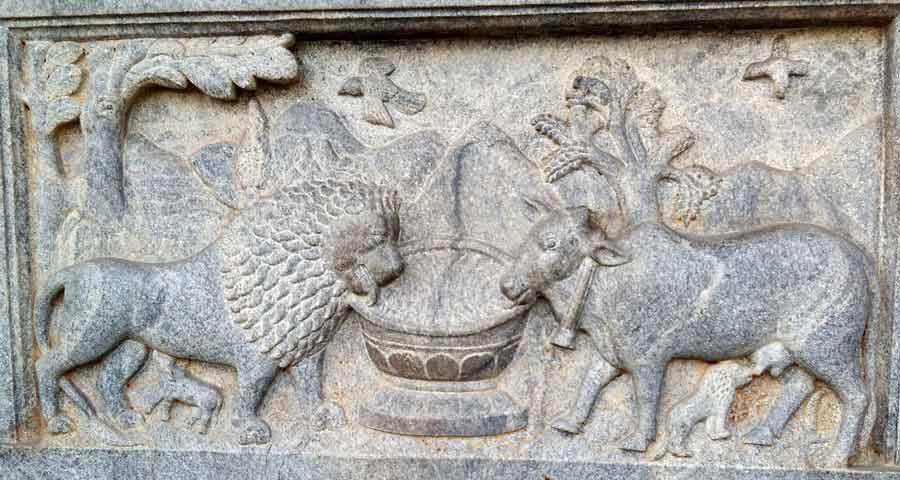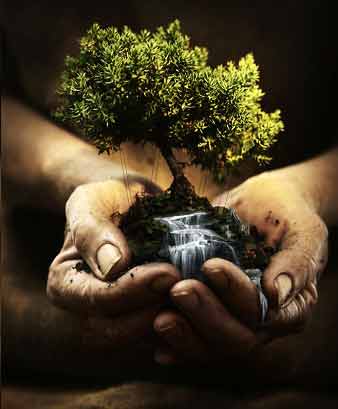
Sculpture depicting Ahimsa (non-injury) Ahimsa sthal, Mehrauli, Delhi
An eminent scholar recently came to our university campus and spoke about the role of diverse religious communities of the world and their attitudes toward
the environment. He showed examples from several indigenous communities from the North America, South America, Africa, and Asia. However, when he referred
to the traditions of India, he used these words: "India has the most bizarre culture in the world where even a cobra is worshipped. This is a bit of an
overshoot." What amazed me was that even in this supposedly globalized world that we live in, India continues to mystify scholars. While most Americans are
familiar with the terms such as "yoga" and "Bollywood," Indian perspectives toward the ecology seem to be largely unknown.
It is true that cobras are worshipped by many Hindus, especially on a specific festival dedicated to them (just as there are specific festivals for
mountains, rivers, cows, trees, and hundreds of other gods and goddesses throughout India). What is not commonly known is that Mahatma Gandhi had a brief
encounter with a cobra at his ashram (retreat) once and he too did not want it to be killed by his colleagues. This is one of the shining examples
of Indian environmentalism, not an "overshoot" as called by our scholar friend mentioned above. Several scientific studies have pointed out that every
being in nature is intrinsically valuable because every other being is directly or indirectly dependent on each other's survival; this is the fundamental
motivation of scientists and environmentalists to save the biodiversity in every part of our planet. Therefore, even a cobra has the right to survive.
Moreover, other beings have an intrinsic duty to protect it as long as it is not a threat to them.
More than 2500 years ago in India, Mahavira and Buddha taught the same concept, although in a different framework of philosophy, spirituality, and ethics.
Mahavira, the last great teacher of Jainism, even proclaimed that ahimsa (Nonviolence) is the greatest dharma (Dharma's meanings include
religion, ethics, duty, virtue, righteousness, and cosmic law). Several Hindu and Buddhist texts also propound the same principle in different languages.
According to most of these texts, ahimsa improves one's karma. For observant Hindus, Jains, and Buddhists, hurting or harming another being damages one's
karma and obstructs advancement toward moksha (liberation). To prevent the further accrual of bad karma, they are instructed to avoid activities
associated with violence and to follow a vegetarian diet (meat consumption in India has historically been very less compared to elsewhere). They also
oppose the institutionalized breeding and killing of animals, birds, and fish for human consumption. In 2011, my book was published based on my research with three communities in India and the diaspora with
several ecological practices inspired by the Indic traditions.
Although yoga is widely known in the West, what is not so widely known is that yoga is a system of eight "limbs" or components. The very first step of the
first limb of yoga is ahimsa. Unless one is firmly rooted in ahimsa in one's thoughts, speech, and actions, true practice of yoga cannot begin. In
addition, since Gandhi was a dedicated practitioner of ahimsa (and other yogic principles), he can be called a great yogi even though he might not have
practiced all the stretching exercises that we commonly refer to as yoga. It is this practice of yoga that develops one's harmony with and reverence for
nature in which even a cobra is not to be killed.

When I first mentioned this to my own students recently, one immediately questioned me and asked if Indians in India are not following the principles of
Gandhi, how can we expect others? I partially agreed with her. India (and many other emerging nations in the world) is enthusiastically aping the West with
its ever-expanding economy and ever-shrinking natural resources. I was also asked recently at a conference on World Religions and Ecology, what do the
non-Western countries expect of the Western countries? If the rest of the world is eager to make the same mistakes as the West did, what route should the
West now take to ensure the planet's survival? Perhaps, one answer could be to embrace Gandhi and his ecological practices. If the West is to remain the
intellectual leader of the world, the quicker it reforms and transforms itself, the better for our planet. While the West continues to crave more natural
resources without changing its lifestyle, it will continue to lack the moral authority to preach to other cultures. It was the West who led the world with
its modern scientific and technological innovations for the last several centuries. It will have to be the West who emerges as a new ecological leader,
with Gandhi as the foundation of its lifestyle. All voices to save the planet's ecology are hollow rhetoric until that happens.
There cannot be and should not be separate "war on terrorism", "war on climate change", "war on drugs", "war on corruption", "war on obesity", and so on.
Our physical, mental, and spiritual health, the environment, the global security and international peace, social justice, it seems like everything will get
a great boost if we first become non-violent in our most basic activity: eating and surviving. "We are what we eat", it is such a simple statement and yet
is so widely ignored all over the world. This is the way Gandhi lived everyday and his protest against the imperial power was influential because it was
based on his own great life unlike many contemporary activists whose own lives are nowhere close to the Gandhi's. Gandhi's entire life can be seen as an
ecological treatise. This is one life in which every minute act, emotion or thought functioned much like an ecosystem: his small meals of nuts and fruits,
his morning ablutions and everyday bodily practices, his periodic observances of silence, his morning walks, his cultivation of the small as much as of the
big, his spinning wheel, his abhorrence of waste, his resorting to basic Hindu and Jain values of truth, nonviolence, celibacy and fasting. The moralists,
nonviolent activists, feminists, journalists, social reformers, trade union leaders, peasants, prohibitionists, nature-cure lovers, renouncers and
environmentalists all take their inspirations from Gandhi's life and other dharmic teachings.

As an alternative perspective on contemporary India, despite all the recent advances in India’s economy and consumerism, Gandhi's inspiration still thrives
in modern India. Here are contemporary environmental activists and dharmic leaders who have modeled their lives taking their inspirations from dharmic
teachings of India or have resisted the global consumerist pressure in various other ways: Sunderlal Bahuguna (now in his 80s, leader of the famous Chipko
Movement in North India), Medha Patkar (A strong voice against big dams in Central India), Dr. Vandana Shiva (fierce critic of Western style globalism and
capitalism), Anna Hazare (He was in headlines recently for his major protest against political corruption, also famous for his ecological experiments in
his village in Central India), Pandurang Hedge (man who is leading Chipko style movement in South India), late Pandurang Shastri Athavale (I have written
about his global Swadhyaya Parivar in my book), late Anil Agarwal (Founder of Center for Science and Environment), Dr. Ramachandra Guha (Another fierce
critic of Western style consumerism, capitalism, and Western style environmentalism including deep ecology), and hundreds of smaller voices spread all over
India making India the land of biggest environmental movement on the planet (as noted by Dr. Christopher Chapple in his volume on Hinduism and Ecology
published by Harvard University). There are also dozens of institutions in several Indian towns founded by Gandhi himself that are still flourishing with
their own small-scale production of textiles and agriculture. In addition, almost every Indian political party must use at least the rhetoric based on
Gandhi's values whenever there is a discussion on taking technology or any kind of help from the USA, UK, France or other major Western power. They all
immediately attack their political opponents as if somebody just was “sold out to the West”. Finally, there are several recent major Bollywood blockbusters
with several Gandhi-like figures reminding the audience of the message of Gandhi (non-violence and civil disobedience).
Yes, Gandhi’s immortal soul and other dharmic traditions of India are still vibrant even in the 21st globalized consumerist society. Several
decades ago, in his non-violent movement for civil rights, Dr. Martin Luther King said, "Christ furnished the spirit and motivation, while Gandhi furnished
the method." It is time again to go back to these cherished values propounded by Christ, Gandhi, and Dr. King: nonviolence not just toward other human
beings but also toward the entire earth. All three also practiced and preached an absolute simple lifestyle and it is time again to practice the same
lifestyle.
About Pankaj Jain, Ph.D.
Dr. Pankaj Jain is the author of Dharma and Ecology of Hindu Communities: Sustenance and Sustainability (May 2011), which won the 2012 DANAM Book Award and
the 2011 Uberoi Book Award, and is an Assistant Professor in the Department of Anthropology and the department of Philosophy & Religion Studies. He has
published articles in journals such as Religious Studies Review, Worldviews, Religion Compass, Journal of Vaishnava Studies, Union Seminary Quarterly
Review, and the Journal of Visual Anthropology. He also contributes to the Huffington Post, Washington Post’s forum On Faith, and Patheos.
His research, supported by a Fulbright Fellowship in 2012, and teaching interests include Religion and Ecology, Indian films, and Religions and Cultures of
South Asia and South Asian Diaspora in North America. Before joining UNT, he taught at North Carolina State University, Rutgers, Kean, and New Jersey City
University. Interested in connecting ancient practices with contemporary issues, he is exploring the connections between religious traditions and
sustainability in Hindu and Jain communities in India and the Indian diaspora. He serves as a research affiliate with Harvard University’s Pluralism
Project, as scholar-in-residence with GreenFaith, as a board member of the Society for Hindu Christian Studies, and as the Eco-Dharma Project Director of
Hindu American Seva Charities, an NGO working with the White House Office for the faith-based initiatives. He has presented his research at Columbia
University, University of Massachusetts at Dartmouth, University of South Florida, Florida International University, University of Toledo, Texas Christian
University, High Point University, Lancaster University (UK), Andhra University (India), Univ of Rajasthan (India), and several conferences, high schools,
radio and TV stations, temples, churches, Yoga centers, and other community centers.
He holds a Ph.D. from the University of Iowa and an M.A. from Columbia University (both in Religious Studies). In his “previous life” he had also earned a
B.S. in Computer Science from India and had worked as a software engineer in India and in New Jersey. Dr. Jain is an active member of several academic and
community organizations, is fluent in several Indian languages, and has published poems in Hindi. He was born in Rajasthan and had also lived in Ahmedabad,
Mumbai, Hyderabad, and Karnatak (in India) and in New Jersey, Iowa, North Carolina, and Texas (in the USA). Some of his papers and articles are at: http://unt.academia.edu/PankajJain/Papers and videos are at http://www.youtube.com/pj2017. The Facebook page for his book is at: https://www.facebook.com/DharmaAndEcology.